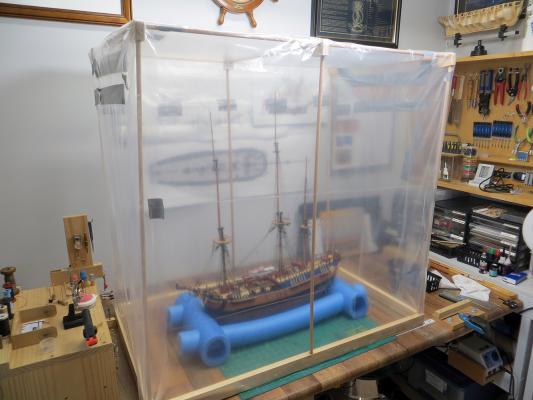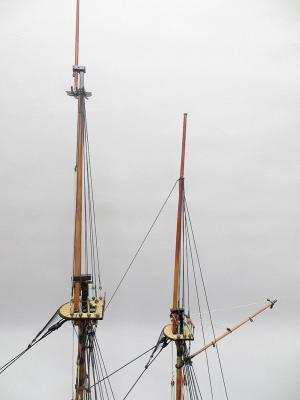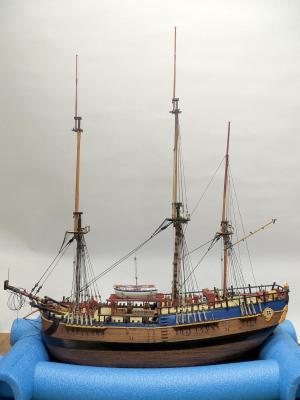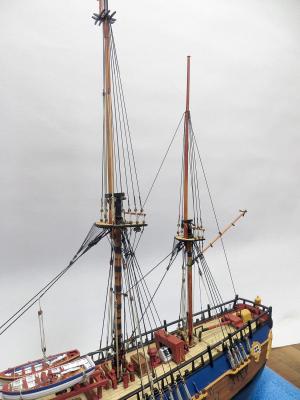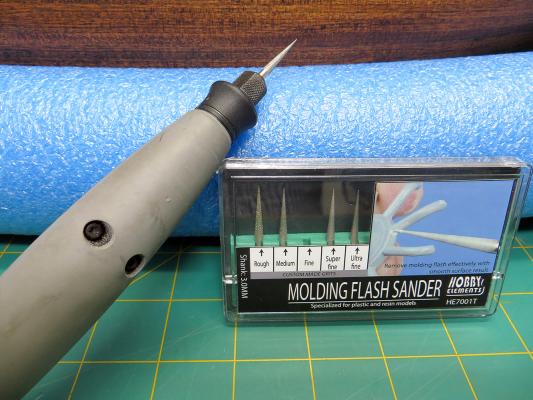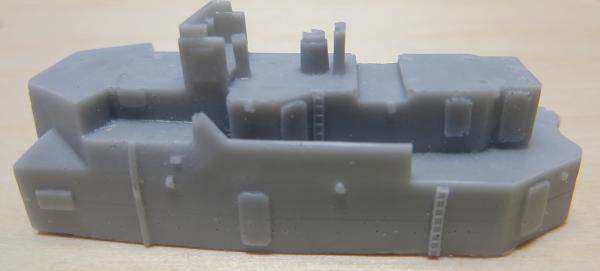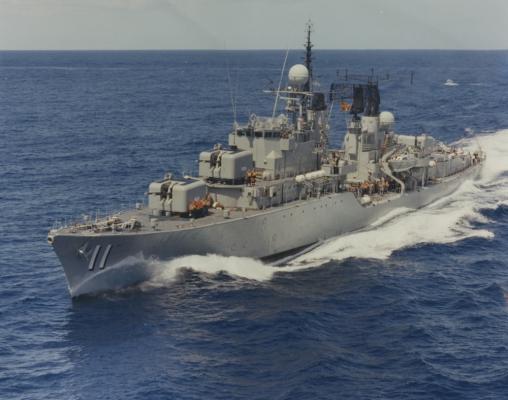-
Posts
5,938 -
Joined
-
Last visited
Content Type
Profiles
Forums
Gallery
Events
Everything posted by BANYAN
-
Hi folks, as promised another small update - slowly getting there. I am now working on the topmasts with only the shrouds on the foretopmast to go at this level. I have also made a temporary cover to act as a dust cover when not working on her. cheers Pat
- 517 replies
-
- Endeavour
- Artesania Latina
-
(and 1 more)
Tagged with:
-
Hi again folks, I have applied some of the resin and waiting for it to fully set to see if this is better than a putty option, which from reports I have read sometimes falls out of resin. I will post a full report once it has set. In the meantime I have made a small start on getting rid of excess flash/moulding etc. While looking around the net for ideas etc I came across the following from Hobby Elements (no connections etc) - it works great on resin. I have it set up in my Dremel shaft for that extra bit of flexibility. It is a 3mm shaft so unfortunately does not fit in the dental tool (2.34mm) cheers Pat
-
Hi all, Thanks for looking in Patrick (great name!), Mark and Dave. Dave Vampire 1 was one of the ships in our old 'V' class and formed part of the 'scrap-iron' flotilla during WWII in the Med. see: http://en.wikipedia.org/wiki/Scrap_Iron_Flotilla - Vampire II, along with Voyager and Vendetta, were named in their honour and followed the RN tradition of renaming ships with the same name if they had 'honourable' names and histories. The scrap iron flotilla proved a very big thorn in the side of German attempts to supply their troops and trying to isolate ours - got quite a name for themselves. The number of names that can be used that start with V are limited so perhaps that is one of the reasons for "Vampire"? Brian, here is an example of what I mean by the pin-holing (you need to open it the larger size); appreciate your interest in this little project. I don't know if this is normal (this degree of holes) for resin or not as it is my first one cheers Pat
-
While assessing the Resin kit version I had decided to change the turrets provided in the kit. A close inspection shows that some of turrets were subtly different. Only B turret had the aerial mounting platform, and other turrets have different numbers of access panels. Bogey (from bogeys bits) was able to create a set that represents the turrets exactly as fitted in Vampire, and with a little more detail than the resin kit version provides. I am still trying to find brass barrels for the 4.5" guns, but will resort the printed ones. If you have a close look at the printed turrets, bogey provides two mounting options, one with, one without the barrels in situ. the design also allows the barrels to be set at any angle you like. There is also more detail provided in the barbette mounting/slip ring under the turret. This was fortuitous, as these parts are now part of the 3D printed kit. These bits are designed by Bogey and printed via shapeways in Frosted Extreme (FXD) Detail which really is great for showing detail, even at this small scale. See: http://www.shapeways.com/product/RVMV7YE2B/hmas-vampire-d11-4-5-inch-mk6-set-1-350-scale?li=shop-results&optionId=57742057&rc=SearchResults The following is a copy of picture from Bogey's page on Shapeways which shows what it can look like when painted. Also shown is a copy of the Limbo Mk10 mortar that will be fitted. Also note that this is a standard turret and that Vampire had 3 panels in hers. These printed items are good value for money and will allow me to show much more detail. Anyone know of a brass barrel manufacturer (at 1:350) for these 4.5" guns (Master does not have them)? cheers Pat
-
Hi John (Neptune) thanks for looking in also. I have done a dry fit of the bits and pieces without having sanded the flash etc off and all seems to align pretty well but there will be a gap where the two hull halves join. As to the pin/holes, a tip I have picked up is to fill them with 5 min brush on resin gel (the stuff fingernail artists use) as it adheres better than putties and works well. I have picked up a bottle and intend to try it this weekend. cheers Pat
-
Hi Chris, yep in a tube in bubble wrap [Edit: I am no longer building the resin version Chris refers to and I discuss below] Not sure about the real quality of this kit yet. While there is a lot of hint of detail, not much is fine detail but at this scale that is to be expected I think? Also there are quite a few air bubble holes (larger than pinholes - probably 1 to 2mm wide, but also pinholes.) and the bubbling/descaling evident on the port bow at the waterline (see first photo). This is all repairable but perhaps should have been caught in QA? Perhaps I may have been expecting too much? I just had a quick look at your Torpedo Boat V108 - a very nice build and excellent finish. Is that a resin also. cheers Pat
-
Hey, great to see and hear from you Marty, thanks for the kudos, but I have seen the work on your models and your more than up to my standards I have just posted a very small update in the Latest Full Photograph section (http://modelshipworld.com/index.php/topic/1589-latest-full-profile-photograph-of-your-build/page-54) and I will be providing a more complete update here at the end of this weekend - I have progressed a little more cheers Pat
- 517 replies
-
- Endeavour
- Artesania Latina
-
(and 1 more)
Tagged with:
-
The following photos show the various aspects of the parts designed by Bogey and printed in 3D (Frosted Extreme Detail - FXD) by Shapeways. This is my first resin 3D printed kit so I do not have much to compare with. That said it appears a sound kit; I certainly cannt complain about detail as Bogey has included everything we could find to represent her appearance in 1975/76. This detail shows up very well even at this scale (1:350). I will provide a more detailed report of all of the bits and pieces as I get to grips with what is / is not provided and where greater detail will be needed. These are the kit bits and pieces provided: There are still a few bits to come (mainly deck fittings), some PE and the decals. I look forward to making a start as the research has been quite enlightening - trying to remember what all the equipment and their locations and arrangements. I must also thanks Jim Lad (John) for the many trips to Vampire photographing all the details for me. cheers Pat
-
Introduction The following overview of HMAS Vampire is adapted from the description provided in Wikipedia. Further details can be found at: http://www.navy.gov.au/hmas-vampire-ii and https://anmm.wordpress.com/tag/hmas-vampire/ The Royal Australian Navy initially ordered four Daring class destroyers, which were to be named after the ships of the "Scrap Iron Flotilla" of World War II. The ships were modified during construction: most changes were made to improve habitability, including the installation of air-conditioning. Vampire and her sister ships were the first all-welded ships to be constructed in Australia. The Darings had a standard displacement of 2,800 tons, which increased to 3,600 tons at full load. Vampire was 390 feet (120 m) long, with a beam of 43 feet (13 m), and a draught of 12 feet 9 inches (3.89 m) at mean, and 14 feet 6 inches (4.42 m) at full or deep load. Her propulsion system consisted of two Foster Wheeler boilers, feeding two English Electric geared turbines, which provided 54,000 horsepower (40,000 kW) to two propeller shafts. Vampire could sail at over 30 knots (56 km/h; 35 mph), and had a range of 3,700 nautical miles (6,900 km; 4,300 mi) at 20 knots (37 km/h; 23 mph). Her standard ship's company consisted of 20 officers and 300 sailors. Vampire was laid down at Cockatoo Island Dockyard in Sydney, New South Wales on 1 July 1952. The destroyer was launched on 27 October 1956 by the wife of the Governor-General, Sir William Slim. She was completed on 22 June 1959, and commissioned into the RAN in Sydney a day later. In June 1970, Vampire was handed over to Williamstown Naval Dockyard for a $US10 million modernisation. Vampire re-entered active service on 4 March 1972. On 25 June 1986, Vampire left active service. She was decommissioned on 13 August 1986, having spent 27 years in service, and travelled 808,026 nautical miles (1,496,464 km). She was later presented to the Australian National Maritime Museum for preservation as a museum ship. I will be depicting her as she was when I served in her in 1973 through to mid-1976 when she was COMAUSDESRON 2 (Commander Australian Destroyer Squadron 2). Her livery will reflect the “pretty work” detail she had when were deployed to the SE Asia station and her visit to the US Bicentennial celebrations. She will therefore be sporting nice white bollards, fairleads and other tiddly bits . At that time, post-refit, her main armament comprised six 4.5-inch (110 mm) Mark V guns mounted in three Mark 6 twin turrets, two forward and one aft. Her anti-aircraft outfit consisted of six 40 mm Bofors; two single mountings on the forward superstructure, and two twin mountings on the aft superstructure. Four 0.5-inch (13 mm) Browning machine guns were carried for point defence. For anti-submarine warfare, a Limbo anti-submarine mortar was carried on the aft deck, offset to port. Vampire was fitted with a Type 170 attack sonar, a Type 174 search sonar, and a Type 185 submarine detection sonar. The fire control directors were two WM22 units. The long range air warning radar was an LW-02, and an 8GR-301A surface search and navigation radar was installed. cheers Pat
-
Hi folks, My next project will be the HMAS Vampire based on a 1:350 #D printed model from Bogeys Bits (via Shapeways). I served a very enjoyable 2.5 years in this ship and it will be a joy building this model of her as it will rekindle many good memories. This photo is from the official RAN website. This log is being started now but no serious work will begin before mid-2016 while I research, acquire detail parts etc and get to grips with working with this material. This is my first non-wood build so I will be learning a lot as I go. In the meantime I will have to devote some serious time to my long-suffering Endeavour (if I don’t, the Admiral will have some stern words ). Introduction Hull Main deck B Deck (forward lower superstructure) X Deck (after lower superstructure) Bridge and GDP (Gun Direction Platform) Main Mast Funnel Radar Superstructure Boats and Davits Main Armament Secondary Armament Cheers Pat
-
Nice looking rope Paul. cheers Pat
-
Chuck, try a jig made from scrap square. Drill out / bore the square first to the size of your dowel (if you have a mate with a lathe get them to do it - much more accurate), then cut it in half. This makes the placement and holding of the round dowels much easier. You can have several sizes all ready to go. Select the appropriate size, hold it vertically/horizontally in a vice and centre it (again easier using the square). A couple of tips; cut dowels to a minimum workable length - the longer the piece the harder to keep it aligned for the vertical bore. For horizontal drilling, use the same jig - again much easier to find the centre line. For regular (repeatable) positioning of these holes use a stop for the round dowel once you have measured up for the first drill. As long as you have taken the time to make the square (jig) centred the rest is a production line effort. cheers Pat
-
Remco, I think they may need to find a new definition for 'perfection" - absolutely stunning joinery. cheers Pat
- 1,215 replies
-
- sloop
- kingfisher
-
(and 1 more)
Tagged with:
-
Now that she has almost all of here 'skin' she is showing those lovely lines to perfection John. Looking great! I might add that around trying to advance his model with his time at the ANM, John has been kind enough to tramp all over the ex HMAS Vampire taking lots of detail shots for me, for an upcoming build - ta mate! cheers Pat
- 745 replies
-
- francis pritt
- mission ship
-
(and 1 more)
Tagged with:
-

HMB Endeavour by mikec - Eaglemoss
BANYAN replied to mikec's topic in - Kit build logs for subjects built from 1751 - 1800
That's a great tip, and nice looking rigging mate - your Endeavour is coming along really nicely. edit: my only concern would be longevity as elastic tends to break down after awhile - have you any feedback from the 'seamstress' in your life cheers Pat -
Errors or not Mark, that's still a nice build and informative log. Best wishes for s a safe and happy festive season. cheers Pat
About us
Modelshipworld - Advancing Ship Modeling through Research
SSL Secured
Your security is important for us so this Website is SSL-Secured
NRG Mailing Address
Nautical Research Guild
237 South Lincoln Street
Westmont IL, 60559-1917
Model Ship World ® and the MSW logo are Registered Trademarks, and belong to the Nautical Research Guild (United States Patent and Trademark Office: No. 6,929,264 & No. 6,929,274, registered Dec. 20, 2022)
Helpful Links
About the NRG
If you enjoy building ship models that are historically accurate as well as beautiful, then The Nautical Research Guild (NRG) is just right for you.
The Guild is a non-profit educational organization whose mission is to “Advance Ship Modeling Through Research”. We provide support to our members in their efforts to raise the quality of their model ships.
The Nautical Research Guild has published our world-renowned quarterly magazine, The Nautical Research Journal, since 1955. The pages of the Journal are full of articles by accomplished ship modelers who show you how they create those exquisite details on their models, and by maritime historians who show you the correct details to build. The Journal is available in both print and digital editions. Go to the NRG web site (www.thenrg.org) to download a complimentary digital copy of the Journal. The NRG also publishes plan sets, books and compilations of back issues of the Journal and the former Ships in Scale and Model Ship Builder magazines.


